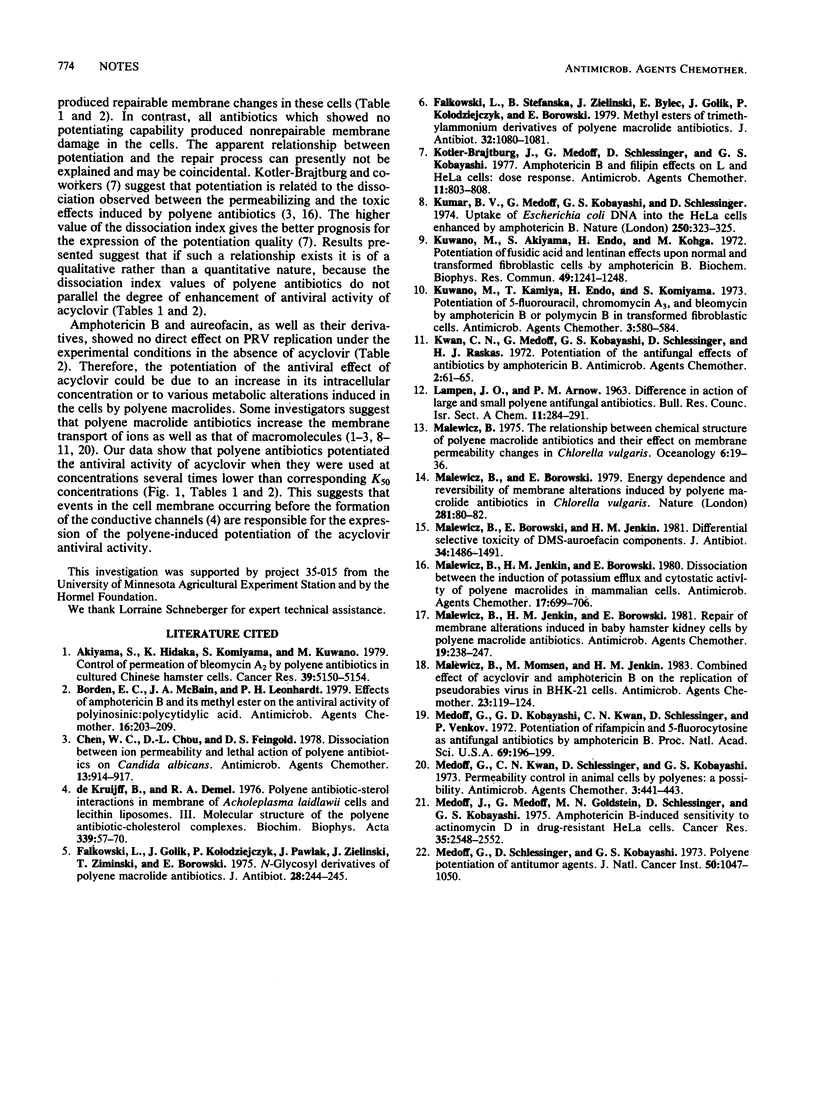Abstract
The potentiation of the antiviral activity of acyclovir [9-[(2-hydroxyethoxy)methyl]guanine] by polyene macrolide antibiotics has been studied as a function of the macrolide structure. The 12 polyenes chosen for this study represented the major structural groups of these antibiotics and induced in mammalian cells repairable membrane alterations or irreversible cell damage. The potentiating activity of the polyene macrolides was determined based on the differential decrease of in vitro production of infectious virions in the presence of acyclovir alone or in combination with the polyene. Pseudorabies virus, a representative herpesvirus susceptible to acyclovir, was replicated in BHK-21 cells grown in serum-free medium to avoid the interference of serum factors in the polyene macrolide-cell interaction. The potentiation activity of the polyene antibiotics was concentration dependent. The enhancement of the antiviral activity of acyclovir was observed at polyene concentrations which had no direct effect on pseudorabies virus replication in BHK-21 cells. The optimal potentiating concentrations of polyenes were 2 to 15 times lower than that inducing 50% of potassium efflux from BHK-21 cells. The highest potentiating activity was observed for the methyl ester of the trimethylammonium derivative of aureofacin B, which reduced the pseudorabies virus titer by two orders of magnitude. Potentiation by polyene macrolides appeared to coincide with the K+-dependent membrane repair process. The acyclovir potentiating activity was associated with polyene macrolide antibiotics having a large and rigid macrolide ring (amphotericin B and aureofacin). Polyene antibiotics with small and rigid (pimaricin and filipin) or large but flexible (nystatin A1 and lienomycin) macrolide rings showed no potentiation of the antiviral effect of acyclovir.
Full text
PDF


Selected References
These references are in PubMed. This may not be the complete list of references from this article.
- Akiyama S. I., Hidaka K., Komiyama S., Kuwano M. Control of permeation of bleomycin A2 by polyene antibiotics in cultured Chinese hamster cells. Cancer Res. 1979 Dec;39(12):5150–5154. [PubMed] [Google Scholar]
- Borden E. C., McBain J. A., Leonhardt P. H. Effects of amphotericin B and its methyl ester on the antiviral activity of polyinosinic:polycytidylic acid. Antimicrob Agents Chemother. 1979 Aug;16(2):203–209. doi: 10.1128/aac.16.2.203. [DOI] [PMC free article] [PubMed] [Google Scholar]
- Chen W. C., Chou D. L., Feingold D. S. Dissociation between ion permeability and the lethal action of polyene antibiotics on Candida albicans. Antimicrob Agents Chemother. 1978 Jun;13(6):914–917. doi: 10.1128/aac.13.6.914. [DOI] [PMC free article] [PubMed] [Google Scholar]
- Falkowski L., Golik J., Kołlodziejczyk P., Pawlak J., Zielinski J. N-glycosyl derivatives of polyene macrolide antibiotics. J Antibiot (Tokyo) 1975 Mar;28(3):244–245. doi: 10.7164/antibiotics.28.244. [DOI] [PubMed] [Google Scholar]
- Falkowski L., Stefańska B., Zieliński J., Bylec E., Golik J., Kołodziejczyk P., Borowski E. Methyl esters of trimethylammonium derivatives of polyene macrolide antibiotics. J Antibiot (Tokyo) 1979 Oct;32(10):1080–1081. doi: 10.7164/antibiotics.32.1080. [DOI] [PubMed] [Google Scholar]
- Kotler-Brajtburg J., Medoff G., Schlessinger D., Kobayashi G. S. Amphotericin B and filipin effects on L and HeLa cells: dose response. Antimicrob Agents Chemother. 1977 May;11(5):803–808. doi: 10.1128/aac.11.5.803. [DOI] [PMC free article] [PubMed] [Google Scholar]
- Kumar B. V., Medoff G., Kobayashi G., Schlessinger D. Uptake of Escherichia coli DNA into HeLa cells enhanced by amphotericin B. Nature. 1974 Jul 26;250(464):323–325. doi: 10.1038/250323a0. [DOI] [PubMed] [Google Scholar]
- Kuwano M., Akiyama S., Endo H., Kohga M. Potentiation of fusidic acid and lentinan effects upon normal and transformed fibroblastic cells by amphotericin B. Biochem Biophys Res Commun. 1972 Dec 4;49(5):1241–1248. doi: 10.1016/0006-291x(72)90601-8. [DOI] [PubMed] [Google Scholar]
- Kuwano M., Kamiya T., Endo H., Komiyama S. Potentiation of 5-fluorouracil, chromomycin A3, and bleomycin by amphotericin B or polymyxin B in transformed fibroblastic cells. Antimicrob Agents Chemother. 1973 May;3(5):580–584. doi: 10.1128/aac.3.5.580. [DOI] [PMC free article] [PubMed] [Google Scholar]
- Kwan C. N., Medoff G., Kobayashi G. S., Schlessinger D., Raskas H. J. Potentiation of the antifungal effects of antibiotics by amphotericin B. Antimicrob Agents Chemother. 1972 Aug;2(2):61–65. doi: 10.1128/aac.2.2.61. [DOI] [PMC free article] [PubMed] [Google Scholar]
- Malewicz B., Borowski E. Energy dependence and reversibility of membrane alterations induced by polyene macrolide antibiotics in Chlorella vulgaris. Nature. 1979 Sep 6;281(5726):80–82. doi: 10.1038/281080a0. [DOI] [PubMed] [Google Scholar]
- Malewicz B., Borowski E., Jenkin H. M. Differential selective toxicity of DMS-aureofacin components. J Antibiot (Tokyo) 1981 Nov;34(11):1486–1491. doi: 10.7164/antibiotics.34.1486. [DOI] [PubMed] [Google Scholar]
- Malewicz B., Jenkin H. M., Borowski E. Dissociation between the induction of potassium efflux and cytostatic activity of polyene macrolides in mammalian cells. Antimicrob Agents Chemother. 1980 Apr;17(4):699–706. doi: 10.1128/aac.17.4.699. [DOI] [PMC free article] [PubMed] [Google Scholar]
- Malewicz B., Jenkin H. M., Borowski E. Repair of membrane alterations induced in baby hamster kidney cells by polyene macrolide antibiotics. Antimicrob Agents Chemother. 1981 Feb;19(2):238–247. doi: 10.1128/aac.19.2.238. [DOI] [PMC free article] [PubMed] [Google Scholar]
- Malewicz B., Momsen M., Jenkin H. M. Combined effect of acyclovir and amphotericin B on the replication of pseudorabies virus in BHK-21 cells. Antimicrob Agents Chemother. 1983 Jan;23(1):119–124. doi: 10.1128/aac.23.1.119. [DOI] [PMC free article] [PubMed] [Google Scholar]
- Medoff G., Kobayashi G. S., Kwan C. N., Schlessinger D., Venkov P. Potentiation of rifampicin and 5-fluorocytosine as antifungal antibiotics by amphotericin B (yeast-membrane permeability-ribosomal RNA-eukaryotic cell-synergism). Proc Natl Acad Sci U S A. 1972 Jan;69(1):196–199. doi: 10.1073/pnas.69.1.196. [DOI] [PMC free article] [PubMed] [Google Scholar]
- Medoff G., Kwan C. N., Schlessinger D., Kobayashi G. S. Permeability control in animal cells by polyenes: a possibility. Antimicrob Agents Chemother. 1973 Mar;3(3):441–443. doi: 10.1128/aac.3.3.441. [DOI] [PMC free article] [PubMed] [Google Scholar]
- Medoff G., Schlessinger D., Kobayashi G. S. Brief communication: polyene potentiation of antitumor agents. J Natl Cancer Inst. 1973 Apr;50(4):1047–1050. doi: 10.1093/jnci/50.4.1047. [DOI] [PubMed] [Google Scholar]
- Medoff J., Medoff G., Goldstein M. N., Schlessinger D., Kobayaski G. S. Amphotericin B-induced sensitivity to actinomycin D in drug-resistant Hela cells. Cancer Res. 1975 Sep;35(9):2548–2552. [PubMed] [Google Scholar]
- de Kruijff B., Demel R. A. Polyene antibiotic-sterol interactions in membranes of Acholeplasma laidlawii cells and lecithin liposomes. 3. Molecular structure of the polyene antibiotic-cholesterol complexes. Biochim Biophys Acta. 1974 Feb 26;339(1):57–70. doi: 10.1016/0005-2736(74)90332-0. [DOI] [PubMed] [Google Scholar]


